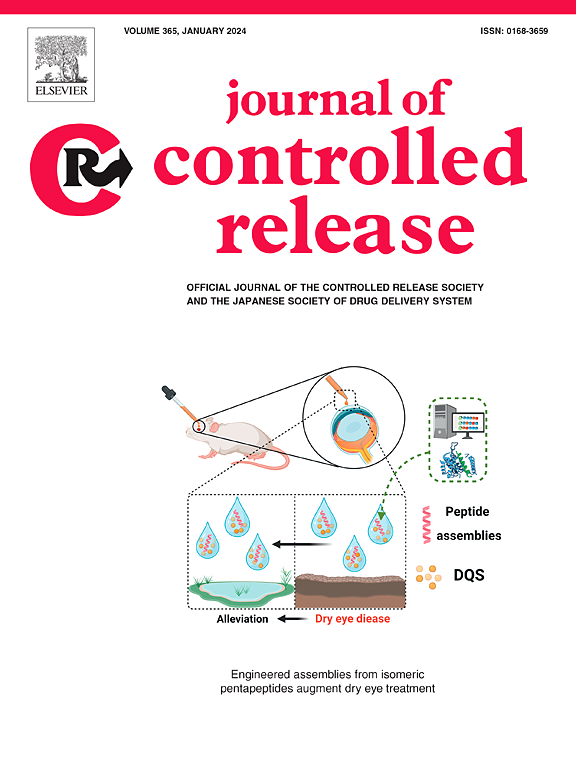A dual-action strategy: Wound microenvironment responsive hydrogel and exosome-mediated glucose regulation enhance inside-out diabetic wound repair
IF 10.5
1区 医学
Q1 CHEMISTRY, MULTIDISCIPLINARY
引用次数: 0
Abstract
Sustained hyperglycemia induces complex pathological microenvironment in diabetic wounds, significantly hindering wound healing. Most current therapeutic approaches (e.g., hydrogel dressings) have paid little attention to the effect of blood glucose levels on diabetic wound healing. In this study, a synergetic therapeutic strategy including a wound microenvironment responsive, multifunctional hydrogel and the exosome-mediated glucose regulation is developed for diabetic wound treatment. First, a gelatin-dopamine (Gel![]() DA) crosslinked hyaluronic acid-phenylboronic acid (HA-PBA) hydrogel (GDHP) is constructed with good injectable, self-healing, and adhesive abilities. Such GDHP hydrogel not only can effectively relieve oxidative stress and reduce inflammation, but also promote keratinocyte migration. Then, ciprofloxacin hydrochloride (CIP·H) is loaded to prepare the GDHPC hydrogel that may respond to diabetic wound microenvironment (e.g., low pH, high glucose and reactive oxygen species) and degrade for controlled release of CIP·H, showing on-demand antibacterial properties. Exosomes derived from human umbilical cord mesenchymal stem cells (hucMSC-exos) are administered via tail vein injection in diabetic mice, which may repair injured pancreatic islets by modulating the pancreatic immune microenvironment, thus promoting insulin secretion and further reducing blood glucose levels. By applying this synergetic therapeutic strategy, the full-thickness cutaneous wounds in type 1 diabetic mice heal well and quickly compared to that treated with the GDHPC hydrogel and the hucMSC-exos alone. This promotion effect on wound healing may associate with reducing inflammation and promoting angiogenesis. This study sheds new light on the development of a dual-action strategy that can effectively maintain glucose homeostasis, improve the wound microenvironment, and consequently promote inside-out repair of diabetic wounds, offering a promising therapeutic avenue for future diabetic wound treatment.
DA) crosslinked hyaluronic acid-phenylboronic acid (HA-PBA) hydrogel (GDHP) is constructed with good injectable, self-healing, and adhesive abilities. Such GDHP hydrogel not only can effectively relieve oxidative stress and reduce inflammation, but also promote keratinocyte migration. Then, ciprofloxacin hydrochloride (CIP·H) is loaded to prepare the GDHPC hydrogel that may respond to diabetic wound microenvironment (e.g., low pH, high glucose and reactive oxygen species) and degrade for controlled release of CIP·H, showing on-demand antibacterial properties. Exosomes derived from human umbilical cord mesenchymal stem cells (hucMSC-exos) are administered via tail vein injection in diabetic mice, which may repair injured pancreatic islets by modulating the pancreatic immune microenvironment, thus promoting insulin secretion and further reducing blood glucose levels. By applying this synergetic therapeutic strategy, the full-thickness cutaneous wounds in type 1 diabetic mice heal well and quickly compared to that treated with the GDHPC hydrogel and the hucMSC-exos alone. This promotion effect on wound healing may associate with reducing inflammation and promoting angiogenesis. This study sheds new light on the development of a dual-action strategy that can effectively maintain glucose homeostasis, improve the wound microenvironment, and consequently promote inside-out repair of diabetic wounds, offering a promising therapeutic avenue for future diabetic wound treatment.


求助全文
约1分钟内获得全文
求助全文
来源期刊

Journal of Controlled Release
医学-化学综合
CiteScore
18.50
自引率
5.60%
发文量
700
审稿时长
39 days
期刊介绍:
The Journal of Controlled Release (JCR) proudly serves as the Official Journal of the Controlled Release Society and the Japan Society of Drug Delivery System.
Dedicated to the broad field of delivery science and technology, JCR publishes high-quality research articles covering drug delivery systems and all facets of formulations. This includes the physicochemical and biological properties of drugs, design and characterization of dosage forms, release mechanisms, in vivo testing, and formulation research and development across pharmaceutical, diagnostic, agricultural, environmental, cosmetic, and food industries.
Priority is given to manuscripts that contribute to the fundamental understanding of principles or demonstrate the advantages of novel technologies in terms of safety and efficacy over current clinical standards. JCR strives to be a leading platform for advancements in delivery science and technology.
 求助内容:
求助内容: 应助结果提醒方式:
应助结果提醒方式:


